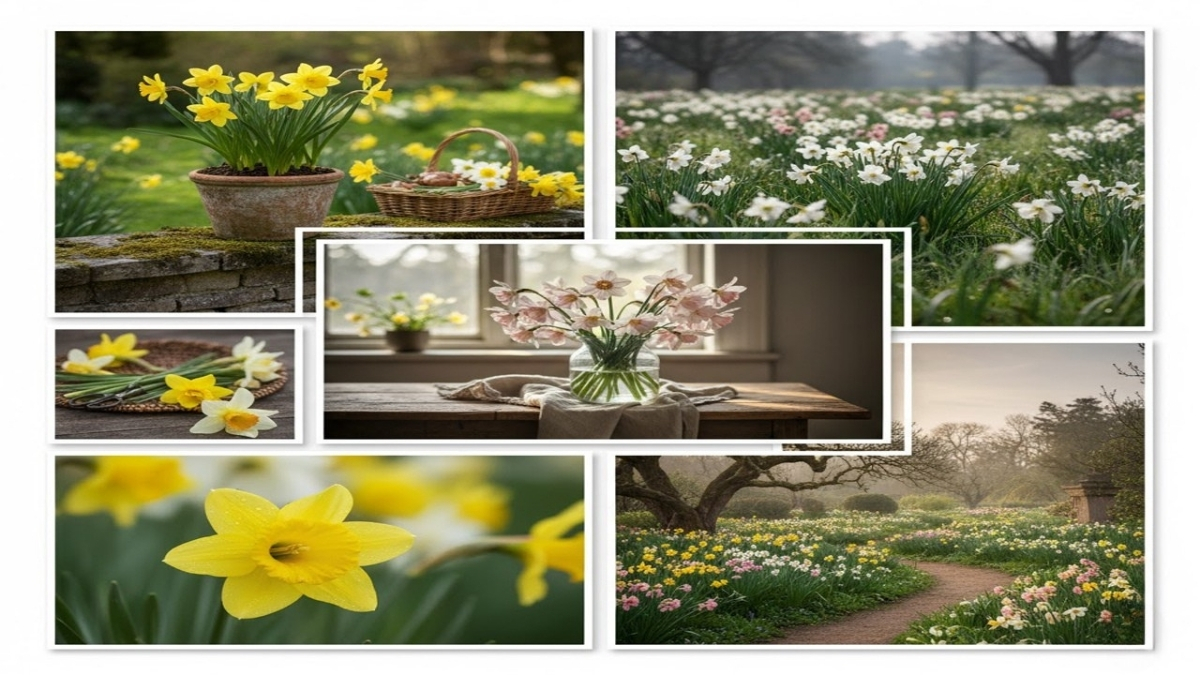Join on WhatsApp
Get the latest updates directly on WhatsApp – motivation, news & more!
Jonquils, often confused with daffodils and narcissus, are a distinct group within the Narcissus genus known for their sweet fragrance, clustered blooms, and slender rush-like leaves. Botanically referred to as Narcissus jonquilla, these spring-flowering bulbs are native to southern Europe and have become garden staples across temperate regions. Whether you’re drawn to the classic yellow jonquil, the creamy white jonquil paperwhite, or miniature varieties like Narcissus quail jonquil, there’s a jonquil for every garden style.
Choosing the Right Jonquil Varieties for Your Garden
With dozens of cultivars available, selecting the right jonquil variety depends on your climate, garden size, and aesthetic preferences. Popular types include the double jonquil with its ruffled petals, the wild jonquil for naturalistic plantings, and the campernelle jonquil, a heritage favorite known for its vigor and scent. For container gardening, mini jonquils and miniature jonquils offer compact charm. If you’re looking for something unique, pink jonquils and giant yellow jonquils add unexpected color to spring beds.
When and Where to Plant Jonquil Bulbs
Jonquil bulbs should be planted in autumn, ideally between late September and early November, depending on your local climate. Choose a site with full sun to partial shade and well-draining soil. Raised beds or sandy loam are ideal, especially in regions with heavy rainfall. Jonquils thrive in USDA zones 4–9 and are well-suited for borders, rock gardens, and pots. If you’re planting jonquils in pots, ensure containers are deep enough to accommodate root growth and have adequate drainage holes.
How to Plant Jonquils for Optimal Growth
Plant jonquil bulbs 4–6 inches deep and 3–4 inches apart, pointy side up. For mass plantings, consider grouping bulbs in clusters of 5–7 for a more natural look. Incorporate compost or aged manure into the soil before planting to boost fertility. Water thoroughly after planting to settle the soil and initiate root development. In colder zones, a layer of mulch helps insulate the bulbs through winter.
Seasonal Care and Maintenance Tips
Jonquils are relatively low-maintenance but benefit from seasonal attention. In early spring, as shoots emerge, apply a balanced fertilizer to support blooming. Deadhead spent flowers to prevent seed formation and redirect energy to the bulb. Allow foliage to die back naturally-this process replenishes the bulb for next year’s growth. Avoid cutting leaves prematurely, as this can weaken the plant. In summer, reduce watering as jonquils enter dormancy.
Growing Jonquils in Containers and Small Spaces
Jonquils adapt well to container gardening, making them ideal for patios, balconies, and small urban spaces. Use a high-quality bulb mix and plant bulbs closer together than in garden beds. Mini jonquils and jonquil paperwhites are especially suited for pots due to their compact size. Keep containers in a sunny spot and water regularly during active growth. After blooming, move pots to a sheltered area and allow foliage to die back before storing or replanting.
Propagation and Division Techniques
Jonquils multiply naturally over time, forming clumps that can be divided every 3–5 years. The best time to divide is late summer or early autumn when bulbs are dormant. Carefully lift the clump, separate the bulbs, and replant immediately. This not only rejuvenates the planting area but also allows you to expand your jonquil collection. Some varieties, like Narcissus jonquilla sweetness, are particularly vigorous and benefit from regular division.
Common Pests and Problems to Watch For
While jonquils are generally pest-resistant, they can occasionally face issues. Bulb rot may occur in poorly drained soils, so avoid overwatering and ensure good drainage. Slugs and snails may nibble on young shoots, especially in damp conditions. Use organic deterrents or physical barriers to protect emerging growth. Aphids can appear in spring-remove them with a strong water spray or insecticidal soap. Jonquils are deer-resistant, making them a reliable choice for wildlife-prone gardens.
Creative Ways to Use Jonquils in Garden Design
Jonquils pair beautifully with other spring bulbs like tulips, hyacinths, and crocuses. Their fragrant blooms and slender foliage add texture and scent to mixed borders. Use jonquils daffodils buttercups in cottage-style plantings or naturalize them in grassy areas for a meadow effect. Double jonquils and jonquil white varieties work well in formal beds, while rush leaf jonquil and wild jonquil lend themselves to woodland edges. For a striking display, combine daffodil & jonquil types in layered plantings with staggered bloom times.
Indoor Forcing and Early Blooming Techniques
Jonquil paperwhites and other early-blooming varieties can be forced indoors for winter cheer. Place bulbs in shallow containers with pebbles and water, ensuring the base of the bulb touches moisture but isn’t submerged. Keep in a cool, dark place until roots form, then move to a sunny window. Within weeks, you’ll enjoy fragrant blooms indoors. This technique is especially popular for holiday décor and early spring celebrations.
Where to Buy Jonquil Bulbs and What to Look For
Quality bulbs are key to successful jonquil cultivation. Look for firm, blemish-free bulbs from reputable suppliers. In Australia, jonquil bunnings is a common search term for local availability. Online nurseries often offer rare varieties like narcissus quail jonquil or n jonquilla. When purchasing, check for cultivar names, bloom time, and fragrance level. Some bulbs may be labeled as jonquil daffodil or jonquil narcissus-these are interchangeable terms within the broader Narcissus family.
Final Thoughts on Growing Jonquils Successfully
Jonquils offer a timeless charm with their sweet scent, cheerful blooms, and adaptability. Whether you’re planting a drift of yellow jonquils in a spring meadow or showcasing miniature jonquils in patio pots, these bulbs reward gardeners with beauty and fragrance year after year. With proper planting, seasonal care, and a touch of creativity, jonquil plants can become a signature feature in your spring garden. From classic varieties to exotic hybrids, the world of jonquils is rich with possibilities-just show me a jonquil, and the season begins.
